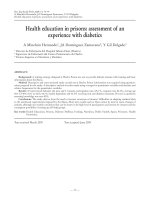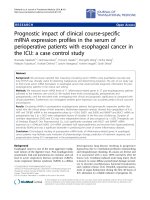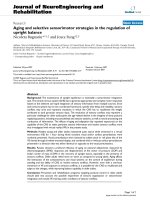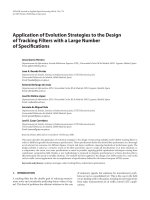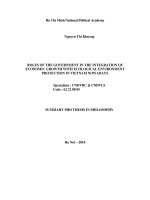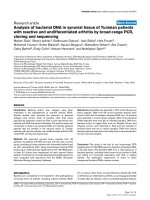Accelerated strategies in the assessment of emergency patients with possible acute coronary syndromes
Bạn đang xem bản rút gọn của tài liệu. Xem và tải ngay bản đầy đủ của tài liệu tại đây (2.28 MB, 263 trang )
ACCELERATED STRATEGIES IN THE
ASSESSMENT OF EMERGENCY PATIENTS
WITH POSSIBLE ACUTE CORONARY
SYNDROMES
Louise Cullen
MBBS (Hons) FACEM
Submitted in (partial) fulfilment of the requirements for the degree of
Doctor of Philosophy by publication.
School of Public Health
Faculty of Health
Queensland University of Technology
2015
1
Keywords
Acute coronary syndrome (ACS), Accelerated diagnostic protocols (ADP), Acute
myocardial infarction (AMI), Chest pain, Emergency Department (ED).
2
Abstract
This PhD by publication assesses strategies aimed at improving the assessment
process of patients presenting to the Emergency Department with symptoms of
possible acute coronary syndrome. The aim is to determine if more refined biomarker
analysis and risk stratification processes may identify patients at low risk who may
safely be able to be discharged from the Emergency Department. The strategies are
focused on accelerated protocols that maintain clinical safety whist improving the
efficiency of the assessment process. In addition to this, the thesis focuses on clinical
implications of the differences in clinical management strategies based on different
biomarkers and in particular troponin assays. Troponin is the key cardiac biomarker
detected in myocardial necrosis, and therefore is elevated in patients who have had a
myocardial infarction; however the performance and accuracy of different troponin
assays vary. This variation in the precision of the assay to detect low concentrations
may impact the clinical care of patients presenting to Emergency Department with
symptoms of possible ACS.
This is a thesis by publication that compiles the research outcomes of a
cohesive program of research. This program was conducted by an international
consortium within which the author was a joint leader and in particular led the
research conducted at the Royal Brisbane and Women’s hospitals and all sites in
China, Indonesia, Korea, and Thailand involved in the ASPECT trial. She was the
joint principal researcher in the ASPECT (Chapter 4), ADAPT (Chapter 5) and
modified ADAPT (Chapter 6) studies. Additionally the candidate obtained research
funding through granting bodies including Queensland Emergency Medicine
3
Research Foundation and the Royal Brisbane and Women’s Foundation to conduct
the research, and contracted with private companies to allow investigation of preclinical assays.
The objective of this program of research was to contribute the evidence base
for improved guidelines for the management of Acute Coronary Syndrome by
documenting the significance, safety and effectiveness of rapid use of existing
troponin assays and use of highly sensitive assays for troponin, in addition to novel
accelerated risk assessment processes. The outcomes of this program have been
extensively published by the international consortium. The candidate has contributed
to more than 50 published papers (12 as first author) in peer reviewed journals over
the last six years in very high ranking journals including one paper published in
Lancet. Further articles remain under consideration. Additionally she has authored
four book chapters (two as first author) and has had over 22 conference abstracts
published. The research reported in this thesis address the core concepts, data
collection and analytical methods, safety and clinical effectiveness of enhanced use
of troponin testing, accelerated diagnostic protocols and the practical application of
rapid assessment processes in clinical care. The publications chosen for inclusion in
this thesis are those that speak to the core principles of ACS evaluation and which
tests the clinical effectiveness of new analytical methods.
Chapter 1 provides an overview of the clinical issue and of the research
program and introduces the aims, objectives and research questions. An overview of
the clinical context and literature provides the ground work for the design of the
research and the methods used.
4
Chapter 2 (Publication one) defines the current process of assessment and
outcomes in the assessment of ED patients based on the current National Heart
Foundation and Cardiac Society of Australia and New Zealand (NHF/CSANZ)
Society Guidelines. This paper aims to establish a baseline by which improved
strategies can be measured in terms of their safety, efficiency and costs.
Chapter 3 (Publication two) provides a robust description of data elements and
their definitions combined into a standardised dataset for use in ED-based research of
patients with possible ACS. This provides the framework for consistent reporting in
ED-based publications investigating patients with chest pain.
Chapter 4 (Publication three) investigates the safety of an accelerated
diagnostic protocol (ADP), using a multi-marker approach in a prospective,
international multi-centred observational trial evaluation involving 3582 patients
from nine countries.
Chapter 5 (Publication four) assesses the safety of the ADP for the assessment
of ED patients with chest pain, however in this project, the multi-marker approach
was replaced with a single cardiac biomarker, troponin, measured by sensitive
troponin assays. This study drew participants (n= 1975) from a subset of the cohort
used in Chapter 4. It involved only patients recruited in Brisbane, Australia and
Christchurch, New Zealand.
Chapter 6 (Publication five) refined the ADAPT accelerated diagnostic
pathway replacing the troponin results from sensitive troponin assays with troponin
results from a new high sensitivity troponin I assay. At the time of this study, the
new assay did not have TGA approval for clinical use in Australia. The results were
obtained from the analysis of stored samples collected during the ASPECT study
outlined in Chapter 4 and involved 1635 patients. In addition, this chapter also
5
describes the first independent validation of the Modified ADAPT ADP in a welldescribed geographically distinct cohort from the Advantageous Predictors of Acute
Coronary Syndrome Evaluation (APACE) Study led by Prof. Christian Mueller in
Basel, Switzerland (n=909).
Chapter 7 (Publication six) reports on the translation of research described in
Chapter 5 into clinical practice, with the implementation of the ADAPT ADP at the
Nambour General Hospital, Queensland, Australia.
Chapter 8 aims to draw together the findings of the program of research and to
express the implications and application of those findings to clinical practice.
Accelerated diagnostic protocols for the assessment of patients presenting to
the Emergency Department with symptoms of possible ACS are safe and effective at
identifying low risk patients who can be managed in an outpatient setting. It is
estimated that over 20% of patients presenting to the ED with chest pain could be
safely discharged significantly reducing the health system cost.
This important
finding will inform clinicians and health services about improvements that can be
made at this current time in the process of care of ED patients.
Key areas of investigation that still require research have been uncovered
during this study. The true implication of the analytical differences in troponin assays
on actual patient care and outcomes requires additional examination. Recently there
has been much interest in point-of-care analysers, which have the benefit over labbased assays in that the time that results are available to clinicians is more rapid. In
addition they do not require the infrastructure of a laboratory to run the tests, making
6
them most useful in rural and regional areas. The analytical characteristics of theses
assays though are significantly different to most lab assays and the true implications
of their use, including safety and patient flow issues in the setting of an ADP are
currently unknown.
Notes
Permission has been granted by all co-authors for the inclusion of the papers in
this manuscript. Additionally the publishers of the relevant Journals have all
provided approval for the incorporation of the articles used in this thesis.
7
8
Table of Contents
Keywords ..................................................................................................................................2
Abstract .....................................................................................................................................3
List of Abbreviations ..............................................................................................................11
Statement of Original Authorship ...........................................................................................13
Preamble .................................................................................................................................15
Chapter 1. Introduction ...........................................................................................................17
Chapter 2. Paper One. .............................................................................................................31
Chapter 3. Paper Two .............................................................................................................61
Chapter 4. Paper Three .........................................................................................................107
Chapter 5. Paper Four ...........................................................................................................143
Chapter 6. Paper Five ............................................................................................................177
Chapter 7. Paper Six .............................................................................................................215
Chapter 8. Summary and Conclusions ..................................................................................231
Acknowledgements ...............................................................................................................241
References .............................................................................................................................243
List of publications by Candidate .........................................................................................248
9
10
List of Abbreviations
ACS
Acute Coronary Syndrome
ADP
Accelerated Diagnostic Protocol
ADAPT
2-Hour Accelerated Diagnostic Protocol to Assess Patients
With Chest Pain Symptoms Using Contemporary Troponins as
the Only Biomarker
ASPECT
ASia-Pacific Evaluation of Chest pain Trial
AMI
Acute Myocardial Infarction
cTn
Cardiac Troponin
cTnI
Cardiac Troponin I
ED
Emergency Department
Hs-cTn
Highly Sensitive Cardiac Troponin
MACE
Major Adverse Cardiac Event
STEMI
ST-Segment Elevation Myocardial Infarction
TIMI
Thrombolysis In Myocardial Infarction
UAP
Unstable angina pectoris
11
12
Statement of Original Authorship
The work contained in this thesis has not been previously submitted to meet
requirements for an award at this or any other higher education institution. To the
best of my knowledge and belief, the thesis contains no material previously
published or written by another person except where due reference is made.
QUT Verified Signature
Signature:
Date:
15th August, 2015
13
14
Preamble
The Royal Brisbane and Women’s hospital Emergency Department
(ED), a tertiary teaching ED in Queensland Australia, assesses approximately 75 000
patients per annum. Six percent of these have symptoms of possible Acute Coronary
Syndrome (ACS). The current National Heart Foundation and Cardiac Society of
Australia and New Zealand (NHF/CSANZ) Guidelines have been followed at our
institution since 2003, in a format known as the Queensland Chest Pain Pathway,
which outline the assessment process and management of such patients. Although
there was no data reported at the time, my impression from managing many of these
ED patients was that the majority did not have a final diagnosis of ACS. I believed
the rule-out process was unduly lengthy and that there may be patients who could be
identified that did not need such a rigorous inpatient assessment process. My aim in
my research endeavours was to comprehensively assess possible strategies for
accelerating this assessment process, with the hope that if a safe and effective
strategy could be identified, it could be implemented in practice, leading to a
reduction in costs for patients and the health care system.
15
16
1
Introduction
17
18
Introduction
Chest pain is one of the primary symptoms leading to patients presenting
acutely
to
Emergency
Departments
(1,
2).
Many
different
underlying
pathophysiological processes can cause chest pain, however the most common,
serious cause is an Acute Coronary Syndrome (ACS). ACS incorporates the clinical
conditions of acute myocardial infarction (AMI) and unstable angina pectoris (UAP).
Myocardial infarction results in necrosis of myocardial tissues which results in the
release of proteins (biomarkers) which can be measured; the presence of which may
confirm the presence of infarction. The diagnosis (rule-in) of ACS is based on
clinical assessment and includes electrocardiograph (ECG) and cardiac troponin
(cTn) measurement.
The focus for ED physicians assessing patients with chest pain is not only to
rapidly rule-in ACS, but to also rule-out this condition and other high risk conditions
that may lead to morbidity and mortality. The majority of patients investigated for
ACS do not have the disease; with some studies reporting up to 90% of all patients
investigated having normal findings (1, 3-5). The serious consequences of a missed
diagnosis of AMI, that occur in 2-6% of ED presentations (6, 7), coupled with the
high rate of atypical presentations for AMI (8, 9), encourages clinicians to rigorously
investigate large numbers of ED patients with possible ACS and in most
circumstances, to admit patients to hospital for prolonged investigation and
monitoring. If it were possible to accurately and safely rule out patients who do not
have myocardial infarction, then it would be possible to safely manage those patients
in the outpatient environment.
19
.
The key biomarker in the detection of myocardial necrosis (cardiac cell death)
is troponin. Troponin assays came into clinical use in the late 1990s, and have
evolved to replace previous, less specific markers such as creatine kinase (CK),
aspartate aminotransferase (AST) and lactate dehydrogenase (LDH). The degree of
elevation of troponin is indicative of the amount of cell death. The diagnosis (rule-in)
of ACS is based not only on cardiac troponin (cTn) measurement, but includes the
clinical context and clinical assessment including electrocardiograph (ECG)
recordings.
International guidelines utilising troponin testing in the assessment of patients
with possible ACS emerged in the early 2000s (10, 11). The National Heart
Foundation and Cardiac Society of Australia and New Zealand (NHF/CSANZ)
developed guidelines in 2000, and updated these in 2006 and 2011 (12-14). These
guidelines risk stratify patients using clinical features, electrocardiograph findings
and serial troponin results, and outline the process of assessment and management
for patients with possible ACS. The recommendations include troponin testing on
presentation and ≥ 6 hours after presentation to the ED using sensitive troponin
assays.
They recommend further objective testing for coronary artery disease
following negative serial troponin and ECG results. Although not formally reported
previously, due to the delayed serial testing and ongoing investigations, the
assessment process is lengthy.
Emergency Departments (EDs) are under mounting strain, with an increasing,
and aging population (15) and rising financial constraints. It is clear that there is an
increase in morbidity and mortality directly associated with overcrowding in EDs
20
(16, 17), and strategies that reduced the length of assessment whilst maintaining
safety should be explored.
Literature review
ACS is a term that encompasses the disease entities of unstable angina pectoris
(UAP), non-ST-segment elevation myocardial infarction (NSTEMI) and ST-segment
elevation myocardial infarction (STEMI). Chest pain is the most common symptom
described for Emergency Department (ED) presentations of patients with possible
ACS (18). Establishing a diagnosis of acute coronary syndrome (ACS) is vital in
treating these patients.
While the initial electrocardiograph is of great clinical importance in the
diagnosis of STEMIs, cardiac biomarkers, in particular troponin, have an important
role in the diagnosis of NSTEMI (19). Troponin is released following myocardial
necrosis, with a change in concentration over time being the basis for the diagnosis
of AMI and underpinning the importance of the serial measurement of troponin.
International guidelines, including the recommendations of the American
College of Cardiology (ACC) and the European Society of Cardiology (ESC)
outlined criteria to diagnose AMI in 2000 (20). These guidelines introduced the
concept of a typical rise or gradual fall in troponin as a component of AMI diagnosis.
These recommendations were further refined by the American Heart Association
(AHA) in 2003 (21). The definition of an adequate set of biomarkers has evolved
with assay development, and is defined as a set of samples at least 6 hours apart
using sensitive troponin assays, and at least 3 hours apart using highly sensitive
assays, with at least one biomarker exceeding the 99th percentile of the distribution
21
of a reference population or the lowest level at which a 10% coefficient of variation
can be demonstrated in a laboratory test (13, 19, 22, 23).
It is recognized that biomarkers and electrocardiographs though in isolation do
not support the diagnosis of AMI. The most recent Universal Definition of
Myocardial infarction published in 2012, describes the detection of elevated cardiac
markers preferably troponin with evidence of myocardial ischaemia, and at least one
of the following: (a) ischaemic symptoms, (b) ECG changes indicative of ischaemia,
(c) development of pathological Q waves or (d) imaging evidence of new loss of
viable myocardium or new regional wall abnormalities as diagnostic (22).
The Guidelines of the Management of Acute Coronary Syndrome 2006 (12)
published by the National Heart Foundation of Australia and the Cardiac Society of
Australia and New Zealand, have recommendations for assessing patients with
possible ACS that are in keeping with international standards. The guidelines include
repeat testing for troponin and electrocardiographs at least 6 - 12 hours after
presentation when troponin testing is performed using sensitive troponin assays. In
patients with troponin values that are normal on initial testing and normal ECGs,
further provocative testing such as exercise stress tests or myocardial perfusion scans
are recommended to rule out underlying coronary artery disease and ACS. The
recommendations aim to define the likelihood of an ACS as the cause of a patient’s
presentation thorough this risk stratification process. The final outcome of this
process is the classification into low, intermediate or high risk groups for ACS. Such
risk stratification is focused mainly on the identification of diseases, and anecdotally
is time-consuming and likely to be costly; however cost analyses have not to date
been reported about this process.
22
In 2011 the Addendum to these guidelines were published, with alteration to
the troponin testing interval when using a highly sensitive troponin assay. In keeping
with other international bodies’ recommendations, the most recent Australian
guidelines support 0 and 3 hour troponin testing, and highlight the significance of a
change in values over time for the diagnosis of AMI (13).
For many reasons, including the possibility of over-investigation of some
patients and the time-consuming nature of international guidelines, much interest has
been placed on the development of clinical decision rules aimed at identifying very
low risk patients who may not require the recommended extensive assessment
processes. Reports of methods to accelerate the assessment process of patients with
possible ACS began to emerge. These include the Vancouver Chest pain rule (24)
and Marsan’s rule (25), and other risk stratification tools such as those by Hess (26),
Kline (27), Goldman (28) in addition to assessment of scores (such and the TIMI
(29) risk score) that were not initially designed for use in the ED. The applicability
and performance of these tools for use in Australian ED for patients with chest pain
had not been reported at the start of this PhD, however subsequently we and others
have investigated some of these rules and even newer risk stratification tools, such as
the HEART score, that have been published over the period of time this research
work has occurred (30-33).
At the commencement of this PhD, strategies designed to reduce the time to
safely assess ED patients with symptoms of possible ACS, whist maintaining
accuracy and safety of such risk stratification were focused on three main areas.
These included firstly the development of risk stratification tools to identify very-low
risk groups of patients that can be discharged without prolonged ED admission (24,
25, 27). For instance, Christenson et al (24) in 2006 reported the Vancouver Chest
23
Pain Rule for early discharge of patient less than 40 years of age, with a normal ECG
and no previous ischaemic chest pain who are deemed very-low risk patients. This
research was validated in our cohort and published in 2013 with sensitive troponin
assay results and 2014 with highly sensitive troponin results (34, 35).
Secondly, novel biomarkers and combination of biomarkers were investigated
to improve accuracy of risk stratification (36-39). It was reported that the combined
negative troponin and myoglobin values at 90 minutes was a valid tool to exclude
significant ACS (40, 41) and the combination of troponin, creatinine kinase and
myoglobin on presentation of NSTEMI patients has a high sensitivity (97%) for the
detection of myocardial infarction (42).
Finally, investigation of novel biomarker strategies occurred, such as the use of
absolute values versus relative change values and study into different time points for
assessment of biomarkers. Research demonstrated that a change in troponin levels
over 2 hours improved identification of ACS (43, 44). Further, a delta troponin of
20% over a time interval ≥ 3 hours or having one positive specimen ≥6 hours after
chest pain onset had an AMI prevalence equivalent to the American Heart
Association definition (45). Newer, more sensitive assays continued to challenge our
understanding of the ability to identify small but significant changes in troponin
levels (44, 46). We investigated the use of early troponin results, changes (delta) in
troponin results and the effect of incorporation of results from improved troponin
assays in parallel to this PhDs focus (32, 47-54).
Such findings indicated that there were a number of options possible available
for use in early and accurate risk stratification. However, there existed a number of
methodological factors that limited the ability to assess which strategy would be
most appropriate in any emergency department. These included the use of different
24
testing methods in different studies such as point of care testing (POC) (55) and
central laboratory testing, with vast difference in the analytical performance of the
troponin assays used, the use of varying testing times across studies including 90
minutes after presentation (40, 41), and three hours after presentation (46), the use of
different combinations of biomarkers with different cut-off points, small sample size
and single site studies limiting the ability to assess diagnostic accuracy and
generalizability, and variation in outcome data including variable reporting of cardiac
death, AMI and ACS diagnostic rates as endpoints.
Despite all the international efforts, establishing a diagnosis of acute coronary
syndrome (ACS) remained challenging and resource-intensive and research to
improve our practices of assessment was required. A reliable and rapid method of
assessment to rule out significant myocardial ischaemia or necrosis would facilitate
early risk stratification of patients presenting with probable ACS including
potentially allowing safe, early discharge of very-low risk patients, without
unnecessary, expensive and potentially hazardous investigations.
Overall Aims
In 2007 when this project commenced, there were no accelerated assessment
processes reported for the management of ED patients with symptoms of possible
ACS that were designed to be safe and more rapid than the NHF/CSANZ Guidelines.
Therefore this program of research was designed to explore ways in which patients
could be more rapidly and accurately assessed and to identify cost effective and
evidence based management strategies that could be utilised in Australia and
elsewhere.
25
